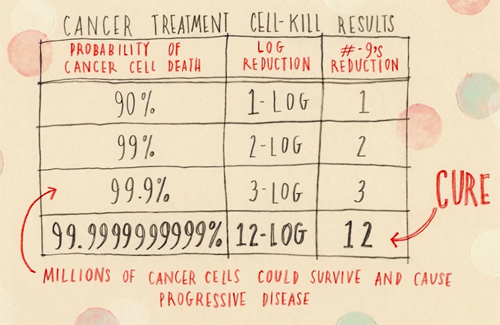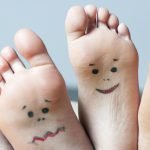Recently, if you read the headlines, you might be starting to think that cancer is something of a chameleon–changing appearances whenever you look at it. And in truth, cancer is a very interesting disease that generates a whole bunch of confusion–not only in the general public, but among doctors as well. And the truth of this can be seen in response to President Obama’s State of the Union Address in which he proposed a “moonshot” effort to end cancer–putting Vice President Biden “in charge of mission control.” As Biden later explained, his effort will have two goals: to increase funding for cancer research and to “break down silos” so researchers can work together and “end cancer as we know it.” Unfortunately, that view of cancer is now considered “outmoded” by most forward thinkers in the medical community.1 Gina Kolata and Gardiner Harrisjan. “‘Moonshot’ to Cure Cancer, to Be Led by Biden, Relies on Outmoded View of Disease.” The New York Times. Jan 13, 2016. (Accessed 16 Jan 2015.) http://www.nytimes.com/2016/01/14/health/moonshot-to-cure-cancer-to-be-led-by-biden-relies-on-outmoded-view-of-disease.html , 2 “What Is Cancer?” American Cancer Society. 04/15/2015. http://www.cancer.org/cancer/cancerbasics/what-is-cancer According to current thinking among experts, the chameleon no longer looks like one disease, but many different diseases that can occur in many different organs, each with its own pathology and symptoms. If this turns out to be true, then there is no such thing as a “cure for cancer.” You would have to find many different cures–one for each different kind of cancer. Fortunately, as we will discuss in this newsletter, current thinking may not be entirely correct. In truth, how you perceive cancer, to mix metaphors, may very well depend on whether you’re looking at the forest or the trees. When you look at the trees (cancer type, pathology, and symptoms), then yes, cancer is many diseases. But when you look at cancer’s fundamental nature (your own body’s cells that have gone rogue as a result of damage to DNA and that no longer think of themselves as being part of the body) then that’s common to all cancers and defines it as one disease.
We notice another area in which cancer looks like a chameleon and that causes confusion when we look at the causes behind the disease. And on this particular issue, the medical community is all over the map. In other words, despite the fact that there is acknowledgement that some causes are directly tied to cancer–smoking causes lung cancer, for example–there are many researchers who believe that getting cancer really is more about bad genes…or just plain bad luck.
In fact, only last year, we looked at a Johns Hopkins Medicine research study that claimed to have “proved” that the primary cause of cancer was bad luck–not diet, not genes, not environment, and not unhealthy habits such as smoking. Just bad luck! Then, a few days ago, a different set of researchers came to the exact opposite conclusion: that the vast majority of your lifetime cancer risk is likely due to external factors–i.e., diet and environmental factors.3 Song Wu, Scott Powers, Wei Zhu, Yusuf A Hannun. “Substantial contribution of extrinsic risk factors to cancer development.” Nature 529, 43–47 (07 January 2016). http://www.nature.com/nature/journal/v529/n7584/full/nature16166.html
 How can this be? How can cancer be such a chameleon and look like one thing and its exact opposite all at the same time? Once again, it comes down to forests and trees. When you look at the trees in the forests, some are oaks, some are pines, and some are maples–and they all look very different from each other. And in the case of cancer, both views of what causes cancer amount to tree spotting. As I have discussed before, when you step back and look at the whole forest, all cancer is fundamentally a disease of the immune system.
How can this be? How can cancer be such a chameleon and look like one thing and its exact opposite all at the same time? Once again, it comes down to forests and trees. When you look at the trees in the forests, some are oaks, some are pines, and some are maples–and they all look very different from each other. And in the case of cancer, both views of what causes cancer amount to tree spotting. As I have discussed before, when you step back and look at the whole forest, all cancer is fundamentally a disease of the immune system.
Before we go any further, though, let’s take a look at the new study that concludes that cancer is diet and environment related. As anyone who has read Lessons from the Miracle Doctors knows, I agree with that assessment–as far as it goes. The problem is that it still represents a limited view–a grove of trees in the forest, If you will–but not the forest itself.
The Study
Ironically, the current study was actually triggered by last year’s study that we referred to earlier and which concluded that cancer was mostly “bad luck” resulting from stem-cell division. In fact, the news study refers to that study in its introduction. “Recent research [last year’s study] has highlighted a strong correlation between tissue-specific cancer risk and the lifetime number of tissue-specific stem-cell divisions. Whether such correlation implies a high unavoidable intrinsic [inherent to the body itself] cancer risk has become a key public health debate with the dissemination of the ‘bad luck’ hypothesis.” Starting with that premise, the researchers decided to analyze its conclusions using multiple methodologies, including stem cell experiments, computer modeling, and molecular “fingerprinting” of cancers.
The result of their analysis was to demonstrate that:
 The correlation between stem-cell division and cancer risk does not distinguish between the effects of intrinsic and extrinsic factors. Specifically, they studied how stem-cells divide in the various parts of the body. If intrinsic (bad luck) factors really are primarily responsible for cancer, it is reasonable to assume that stem cells with similar patterns of division would have a similar risk for turning cancerous. That turned out to not be true, which suggests that external factors [diet, lifestyle, and environment, for example] play a major role.
The correlation between stem-cell division and cancer risk does not distinguish between the effects of intrinsic and extrinsic factors. Specifically, they studied how stem-cells divide in the various parts of the body. If intrinsic (bad luck) factors really are primarily responsible for cancer, it is reasonable to assume that stem cells with similar patterns of division would have a similar risk for turning cancerous. That turned out to not be true, which suggests that external factors [diet, lifestyle, and environment, for example] play a major role.- Intrinsic risk is better estimated by the lower bound risk controlling for total stem-cell divisions. In other words, intrinsic risk is not the major determiner of whether you get cancer or not.
- The rates of internally caused mutation accumulation as the result of bad luck in internal cellular processes are not sufficient to account for the observed cancer risks. This led the researchers to conclude that cancer risk is heavily influenced by extrinsic factors. This was corroborated when researchers also looked at how cancer incidence changes according to where people live. They found that the risk of cancer goes up when people move from a low-risk area to a high-risk area and take on the risk of the high risk area. This clearly indicates that something in the environment or lifestyle of that new place impacts the risk. If nothing else, these results are important for strategizing cancer prevention, research, and public health.
- In the end, the researchers concluded that intrinsic (bad luck) risk factors contribute only modestly (less than ~10–30% of lifetime risk) to cancer development. Or to put that into more easily understood terms, the vast majority–70 to 90 percent–of your lifetime cancer risk is likely due to external factors.
The bottom line is that, contrary to what the media has been promoting for the last year–the study showed that you can’t hide behind bad luck. As most of us in the alternative health community have been saying for decades, your diet and lifestyle choices make a difference. In fact, according to the researchers, those choices–not bad luck–may lie behind as many as 90% of all cancers. Now, to be fair, as I pointed out last year, the “bad luck” study didn’t really say that most cancers were caused by bad luck. The headlines wrongly promoted a finding that the study in question didn’t actually come up with. However, they weren’t entirely to blame for their conclusions as the researchers encouraged that interpretation even though their own data didn’t support it. And a number of talking-head doctors, when presenting their observations of the study to the media, reinforced this misrepresentation. In fact, what the study found is while the majority of most “types” of cancer are caused by bad luck, most of those cancers are of the obscure and very rare variety. On the other hand, the cancers that most people actually get–lung, breast, colon, etc.–are indeed the result of outside factors.
What this Study Means
I normally don’t take bows for my predictions even though I’ve done amazingly well over the years, accurately predicting the eventual outcomes on everything from SARS to Bird Flu as well as Swine Flu to Ebola. And even now, I’m not looking for kudos for challenging last year’s bad luck study, in contrast to most of the mainstream media. As I already said, there are many in our community who held the same position. On the other hand, I did nail the exact percentage of cancers–up to 90%–that seem to be related to diet and environment way before the study came up with those numbers. As I said in my lecture, Cancer, the Big Lie, over 15 years ago:
“It’s relatively easy to reduce the incidence of cancer by close to 90 percent (back to the levels experienced 100 years ago), but no one in the medical community will tell you about it. And how exactly do you cut cancer incidence by 90 percent? Just remove the cancer-causing toxins [the extrinsic factors] from your body–toxins that didn’t even exist 100 years ago but are now present in our bodies in substantial amounts. And start regenerating your body with the essential cancer-preventing nutrients that have been removed from the mass produced, processed foods [another extrinsic factor] that make up the bulk of today’s diet.”
Hitting the precise percentage 15 years before the medical community comes up with the exact same number! Now that’s worth a high five! Also, at the same time, I predicted that the most interesting area of cancer research would involve working with your body’s immune system rather than destroying it. Well, it turns out that prediction too was spot on.

It has been known for more than a century that occasionally there is evidence that a patient’s immune system can attack a metastatic cancer, resulting in a long-lasting remission. However, until very recently, although scientists were aware of the immune system’s role, they had no mechanistic understanding of why the immune system worked to defeat cancer in seemingly random particular patients, but the immune responses could not reliably be repeated in other patients.4 Ribas, Antoni, “Releasing the Brakes on Cancer Immunotherapy.” NEMJ 2015. 373:16 1490-1492. http://www.nejm.org/doi/full/10.1056/NEJMp1510079 From the medical treatment point of view, solving the puzzle of how an immune response can lead to the eradication of cancer requires an understanding how the immune system is specifically activated by certain antigens mostly foreign to the body, rather than by internal immune system triggers. Recent research, though, is now beginning to pull the curtains back on the process. In fact, doctors now know enough that the treatment paradigm has shifted from attempting to “activate” the immune system (the old approach) to “releasing the checkpoints” that downregulate it. Many researches now consider checkpoint-blockade immunotherapy the most exciting advance in cancer treatment in recent years.
Conclusion
The bottom line, to throw in another metaphor, is that cancer is a bit like the ancient Indian story of the six blindfolded men who were asked to determine what an elephant looks like by feeling different parts of the elephant’s body. The blind man who feels a leg says the elephant is like a pillar; the one who feels the tail says the elephant is like a rope; the one who feels the trunk says the elephant is like a tree branch; the one who feels the ear says the elephant is like a hand fan; the one who feels the belly says the elephant is like a wall; and the one who feels the tusk says the elephant is like a solid pipe. Not one of them gets to see the whole elephant, and that’s why they each see something different. When doctors look at the individual manifestations of cancer (lung, colon, breast, pancreatic, etc.), like the blind men looking at the elephant, each type of cancer seems to be a unique disease–each requiring its own treatment. And when you look even closer–at the genetic level–again, every cancer unquestionably seems unique. But if you take your blindfold off and step back–to see the whole elephant rather than his parts, to see the forest instead of the trees–then those differences begin to melt away.
First of all, you see that, like the blind men, all of the doctors who view cancer as multiple diseases are right–within the confines of their blindness. Yes, the elephant’s legs are like pillars and its tusks like pipes, etc. Or in the doctors’ case, each manifestation of cancer appears different with its own unique DNA mutation and each requires its own medical treatment. But then, once you take off your blindfold and look at the entire beast, you see that all cancers share the same twofold nature.
- No matter the cancer, all cancers begin with altered DNA in a single cell that causes that cell to become cancerous–to no longer be part of the body, but to become “other.”
- The immune system, either because it’s weakened or overwhelmed, fails to do its job and destroy the bad cell before it has a chance to multiply, take root, and develop defenses that can now hide from, thwart, or even coopt the immune system itself.
Given this understanding, it’s now easy to see that it’s far easier to prevent cancer than to cure it–and the approach to preventing it is universal across all cancers:
- Eliminate as many factors as possible that accelerate the mutation of cellular DNA, being sure to also detox out all of the toxic elements that are already present in your body.
- Optimize your immune system as much as possible so that it can eliminate rogue cells, as it was designed to do, before those rogue cells become full blown cancer.
- Nutritionally support your body’s fight against cancer with broad spectrum anticancer nutrients such as antioxidants and herbs.
As the study we cited above indicated, this will prevent as many as 90% of all cancers.
Note well: if you do come down with cancer, the game changes. Now, as most medical thinking suggests, you need to make your approach cancer specific. For example, you can no longer use a broad spectrum antioxidant program as some antioxidants will actually protect cancer cells in your body in the same way they protect healthy cells. If you have cancer, you need to eliminate those antioxidants and just up your dosage of the antioxidants that specifically target cancer cells. These would include antioxidants such as EGCG from green tea, curcumin, and NDGA from chaparral.
And on a Different Note
My brother-in-law, Arnie Glazier, is one of the top cancer researchers in the world. As he so eloquently explains, even treatments that are 99.9% effective in getting rid of the cancer cells in your body are still likely to fail. They simply leave too many viable cancer cells behind–potentially millions of surviving cancer cells, actually. To consider yourself cured, or at least in long term remission, you actually have to destroy 99.9999999999% of all the cancer cells in your body. In scientific terms, we’re talking about a 12-log reduction in cancer cells. And all 12 of those 9’s have to be there. With each 9 you remove from the number, you’re talking about an exponential increase in the number of cancer cells surviving in your body.

Since you actually have to destroy 99.9999999999% of all cancer cells to effect a cure, it’s easy to see why most traditional treatments such as chemotherapy and radiation fail. Quite simply, you would have to use so much chemo and so much radiation that you’re more likely to die from the treatment before you kill enough cancer cells to reach the “cure” threshold. My brother-in-law’s explanation of why cancer is so hard to “cure” using traditional medical approaches also illuminates one of the reasons that the potential of immune system therapy, as we discussed earlier, is so exciting. If you activate your immune system, you have more than enough immune cells in your body to actually track down and destroy every single cancer cell in your body–thus achieving that 99.9999999999% kill ratio.
But let’s not get sidetracked. These medical advances, as well as my brother-in-law’s work, which is moving in a different direction, may be just around the corner, but they are still in the future. To repeat the point I made earlier: preventing cancer is a whole lot easier than curing it–and a whole lot less damaging to the body. And while waiting for medical science to find the cure(s) for cancer, you could do far worse than working naturally with your own immune system to take on the disease.

References
| ↑1 | Gina Kolata and Gardiner Harrisjan. “‘Moonshot’ to Cure Cancer, to Be Led by Biden, Relies on Outmoded View of Disease.” The New York Times. Jan 13, 2016. (Accessed 16 Jan 2015.) http://www.nytimes.com/2016/01/14/health/moonshot-to-cure-cancer-to-be-led-by-biden-relies-on-outmoded-view-of-disease.html |
|---|---|
| ↑2 | “What Is Cancer?” American Cancer Society. 04/15/2015. http://www.cancer.org/cancer/cancerbasics/what-is-cancer |
| ↑3 | Song Wu, Scott Powers, Wei Zhu, Yusuf A Hannun. “Substantial contribution of extrinsic risk factors to cancer development.” Nature 529, 43–47 (07 January 2016). http://www.nature.com/nature/journal/v529/n7584/full/nature16166.html |
| ↑4 | Ribas, Antoni, “Releasing the Brakes on Cancer Immunotherapy.” NEMJ 2015. 373:16 1490-1492. http://www.nejm.org/doi/full/10.1056/NEJMp1510079 |












No mention of Warburgs lack
No mention of Warburgs lack of oxygen theory here. What do you think of that?
Jon is quite familiar with
Jon is quite familiar with Warburg’s work. And there’s no question that cancer loves sugar, that it feeds off it, and that it is exacerbated by it. But many other factors have changed over the last 100 years in addition to the increase of sugar in the diet — such as 80,000 chemicals never before seen in nature unleashed upon the environment and the great increase in cigarette smoking seen after WWII. And sugar does not explain the increases in cancer found in areas such as Love Canal, Chernobyl, and Erin Brockovich country. To claim that sugar is the cause of cancer–case solved–is simply not supported by the facts. Sorry.
I do not understand this
I do not understand this comment. The Warburg Effect, which obtained a Nobel Prize is the proof by Warburg that a lack of oxygen will cause cells to become cancerous, and cause these cells to respire by fermentation.
Many alternative practitioners are quoted as curing various cancers with oxygen therapy such as hyperbaric. Ronald Regan has been apparently cured of cancer by such means.
It can hardly be the case that the Warburg Effect has ceased to operate. Not to detract from another cutting edge article by Jon Barron – for which my profound thanks.
I don’t think John is
I don’t think John is suggesting here that sugar is the cause of cancer. Only that the “Warburg Effect” (that is present in ALL cancers) doesn’t get a mention. And boy, does it deserves to be mentioned!
Please read this excellent book and prepare to have your mind blown and your opinion changed:
(I’m not allowed to post URL’s here, so you’ll have to Google it):
Tripping Over the Truth: The Metabolic Theory of Cancer by Travis Christofferson
Selenium supplements, in the
Selenium supplements, in the 3 different forms, attacks / prevents from multiplying, cancer cells in each of its 3 stages. Forgot where I read this recently.
With the different physicians
With the different physicians giving such diametrically opposed view to what “prevention” even means, it can be hard to decide what is really best for me and MY body.
I wish health was the goal rather than mighty profits for all our sakes.
Dear Mr. Barron- your lecture
Dear Mr. Barron- your lecture the nature of cancer is very interesting. You may have filled in the blanks for the medical research community; Though some might not give you credit.
I agree with you mostly.
I do, however, feel that your rendition of the elephant is(somewhat) lacking a feature… where are the tusks?
We must always strive to give all those who are blind in our medical community something to grab hold of.
Great work!
Thank you
George
Good point. The tusks were
Good point. The tusks were probably removed by ivory poachers.
I found the tusks in sixth
I found the tusks in sixth line under Conclusions.
Greetings Once Again, Jon and
Greetings Once Again, Jon and all!
I’d be very interested in knowing whether or not you have been introduced to the discoveries of Dr. Geerd Hamer.. These discoveries include “The Five Biological
Laws. These laws form the basis for the new medicine
that Dr. Hamer named German New Medicine.
The first biological law essentially states that cancer and every other “disease” originates with an emotional shock.
If we consider the psyche as well as the body then “The forest” is much larger than what we are told.
Psyche-Brain-Organ are a whole unity. Focusing only on the physical will not allow the much larger and more true to life holistic view of “the forest”.
Re: “cancer is a very interesting disease that generates a whole bunch of confusion”. I agree with the first part of this statement however isn’t people (and
especially those who are identified with western medical) who generate and perpetuate the confusion? That confusion is based on a medical paradigm that sees disease as something “gone wrong” with the body, a defect of one kind or another.
From the new medicine perspective what most people call disease is actually a highly intelligent special biological survival program. German New Medicine completely explains how this is so. The really good news here is that anyone can learn German New Medicine. See: learninggnm DOT COM.
What if we were to reconsider the belief we have about
disease? A belief that conditions virtually all of us from a young age before we had the ability to think independently, use some logic and reason through the possibility that nature knows what it is doing. A belief that if reconsidered may allow us to begin releasing the fear that also has conditioned
most all of us, and again from very early on before we
were able to really think clearly; especially before we had the courage to question “authority” i.e. the medical authority that is embodied in the medical doctor.
Can we address the self-imposed state of dis-union.[1]
that so many people suffer from in fear when they rely
upon medical doctors for their health? Can we begin to
consider the shock trauma inductions that individuals
receive by way of the pronouncements of both
diagnosis and prognosis when they are uttered by the
doctor authorities?
Could these events be worthy considered as subject matter
for clinical studies? I have no expectations for that
since studies of this nature have nothing to offer our
present day practice of medicine.
It seems a shame to me that what amounts to (most fundamentally) as a soul-less paradigm continually projects a fractionated and constricted materialistic image of and upon individuals that the individuals then accept unconditionally to such an extent that will sacrifice their lives for medical treatment.
Would it be possible for us to see a larger forest here?
Thank you Jon!
[1] a state of separateness from nature and nature’s way
that is embodied within each individual as innate intelligence.
I have several blogs at CureZone.
Yes, Jon is familiar with Dr
Yes, Jon is familiar with Dr. Hamer’s work, and as he has said on numerous occasions, that your emotional/mental state matters hugely when it comes to health. In fact, he devoted an entire chapter (The Thought that Kills) to that premise in his book, “Lessons from the Miracle Doctors.” But, as to all disease originating with mental shock, it simply doesn’t stand up to examination in the real world. For example, it doesn’t explain how living near Love Canal and the dumping of toxic waste or living in Erin Brokovich country and being exposed to chromium 6 can cause cancer—especially when the people who came down with cancer were totally unaware of their exposure to toxic chemicals.
What would you recommend for
What would you recommend for a person without a particular problem requiring a specific treatment. I presume that a good multi-vitamin would be among your recommendations; but what additional supplements would be considered a good base to support one’s basic needs such as your immune system. I am trying to keep my expenditures to around $200/month. Is this possible?
The situation you mention is
The situation you mention is the exact sort of situation that Jon designed the Baseline of Health Program for, outlined in his book “Lessons From the Miracle Doctors.” You can download it for free–it is a must read.
My wife was diagnosed with
My wife was diagnosed with Nasal Mucosal Melanoma, in January of 2015. It’s a very rare cancer (bad luck as you indicated rare cancers are). She was treated by Proton therapy radiation which finished June 6th. She is due to get a PET/CT scan January 27,2016.
To boost her immune system she has been taking LDN (1.5 mg) as well as Ave Ultra. She is also taking curcumin,ALA,zinc, black cumin seed oil vitamin D3, vitamin C, and other supplements.
Do you thinks these will help? Can you recommend others?
Thank You
James Byrne
Everything about cancer was
Everything about cancer was nailed down years ago by the ‘free radical theory of cancer’ – unfortunately this theory was too good so it has been squashed.
Maybe the scientists and
Maybe the scientists and other medics read your earlier (15 years ago) newsletter, shelved it and thought(15 years later) this might be an interesting topic and published it!
If we are lucky in some time they may also find interest in the other articles (Sars, Ebola etc.) and may publish this as new scientific developments!
I’m not sure my comment went
I’m not sure my comment went out to you re my wife’s nasal mucosal melanoma? As this comment section is blank, I thought I had sent one, but this empty comment page is puzzling.
James M. Byrne
It has been posted! We
It has been posted! We manually approve every comment that comes in to avoid spam and to help answer questions. So, just give us a little time to go through each comment and get it posted. Thanks.
Thank you very much for
Thank you very much for posting this excellent article. I also disputed the “bad luck” theory when it came out last year. Nice to know I’m in good company.
What if your cancer is the
What if your cancer is the Immune System? CLL/SLL leukemia and lymphoma.
Than what do you do?
I was diagnosed this June 2015.
Sincerely,
Marina O
Boston, MA
Yes, cancers that take over
Yes, cancers that take over the immune system require a change in emphasis, but ultimately make use of the same fundamental concepts—clean out the things that may be promoting or exacerbating the cancer, and give your body the tools that it needs to fight the cancer. The fact that there have been spontaneous remissions of leukemia and lymphoma tell us that, given the right conditions, your body has the ability to overcome these cancers as well. Jon Barron devotes an entire chapter in his book, Lessons from the Miracle Doctors, to explaining the nature of cancer and how you can complement any treatments you are using with natural alternatives. In fact, the entire book, could be considered a primer on dealing with cancer.
Dr Williams has a report of dewormer with the active ingredient being fenbendazole {FenBen for short} doing some amazing remissions for cancer. Perhaps Jon could look into that.